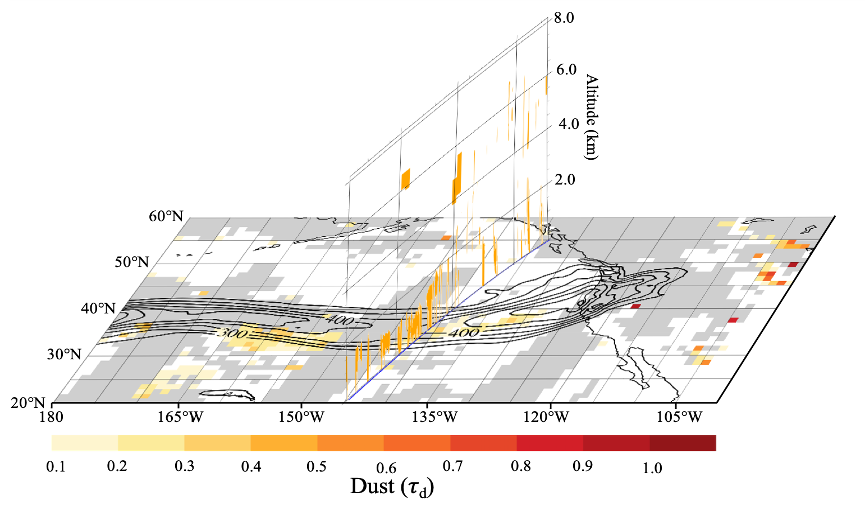CW3E Publication Notice
Dusty Atmospheric Rivers: Characteristics and Origins
July 15, 2020
An article by Dr. Kara Voss, a newly minted PhD from CW3E, and coauthors from Scripps Institution of Oceanography including Dr. Voss’s adviser Amato T. Evan, Kimberly A. Prather, and CW3E Director F. Martin Ralph has been accepted for publication in Journal of Climate. This research was part of Dr. Voss’s dissertation work, which was funded as part of FIRO and the AR Program, and supports two priority areas (FIRO and Atmospheric River (AR) Research and Applications) within CW3E’s 2019-2024 Strategic Plan.
Abstract: The precipitation productivity of an AR is affected by microphysical processes, including the influence of aerosols. Earlier case studies have shown that some ARs over the North Pacific contain dust from Africa and Asia that can strongly influence precipitation by acting as ice nuclei. This paper explores how commonly dust and ARs occur together, or in close proximity (see Figure 1 below). A “dust score” is introduced to characterize the dustiness of the environment associated with ARs using satellite-based observations. This method is applied to days on which one or more ARs made landfall along the west coast of the United States between 2001 and 2018. The dust score is used to describe the seasonality and year-to-year variability of dusty-environment ARs. Dusty ARs occur primarily in the early spring (March-April) (see Figure 2 below) and dust is preferentially found within the warm sector of AR-associated extratropical cyclones. Year-to-year variability in dust score is dependent more on year-to-year variability in dust than on the frequency of AR days. This year-to-year variability is also strongly related to correlations between the frequency of ARs and the dustiness of the northeastern Pacific, motivating additional investigation into potential dynamical association between dust and ARs.
Figure 1: Figure 8 in Voss et al., 2020: Transect from 30 – 50° N near 145° W of CALIPSO Vertical Feature Mask (VFM) dust classification (τd) on 2010-03-29 11:22Z overlaid upon the North Pacific Ocean on that date. The CALIPSO orbital track is shown with a blue line. Contours of IVT greater than 250 kg m—1 s—1 are shown in black.
Figure 2: Figure 11 in Voss et al., 2020: Average number of days each month with ARs making landfall along the contiguous U.S. west coast for the period 2001-2018 grouped by dust-score percentile e.g. AR days with dust score greater than the 90th percentile dust score for the 2001-2018 period fall into the 90th percentile dust score group. ARs with dust scores greater than the 75th percentile dust score occur mostly during the Spring, when the dust season in Asia is at its peak.
Voss, K.K., A.T. Evan, K.A. Prather, and F.M. Ralph, 2020: Dusty Atmospheric Rivers: Characteristics and Origins. J. Climate, 33, 9749-9762, https://doi.org/10.1175/JCLI-D-20-0059.1.


